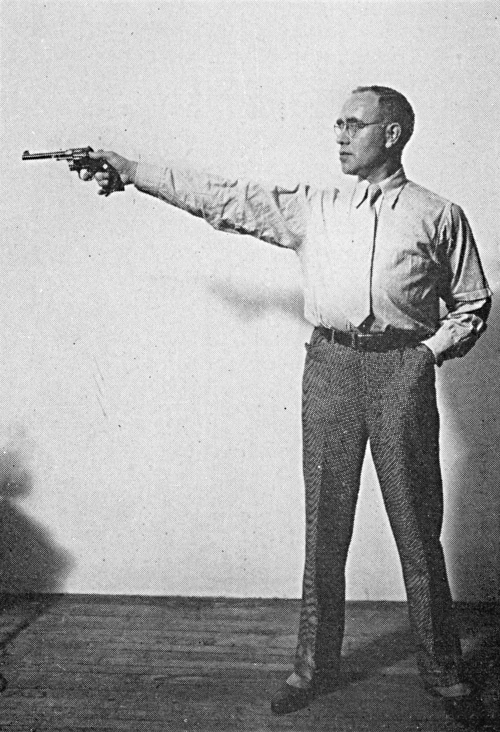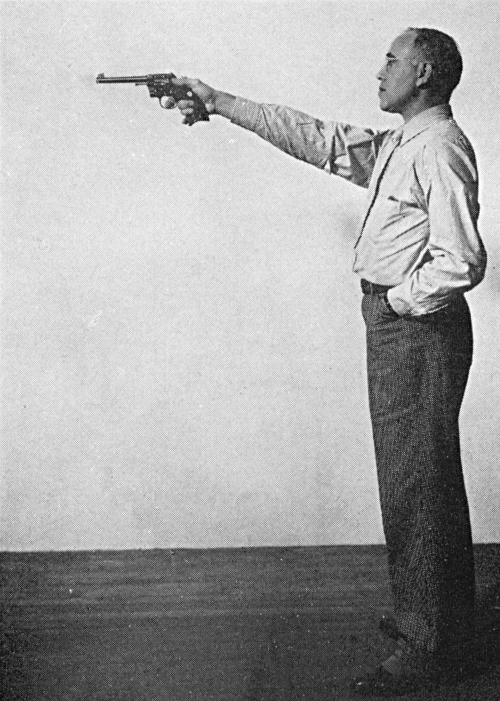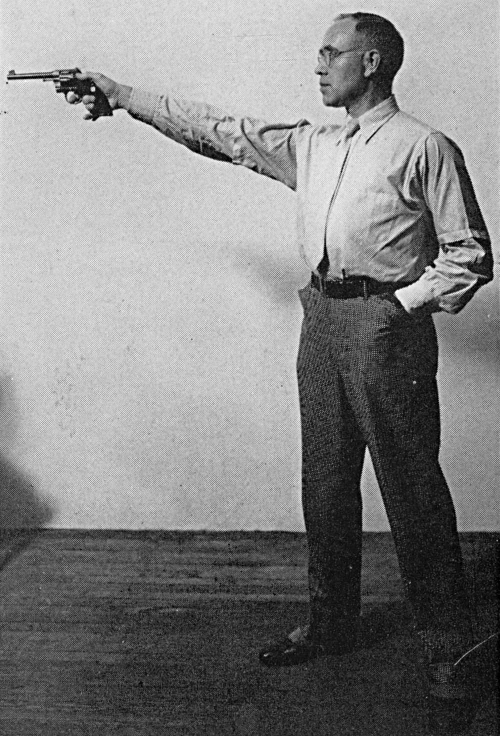The following information comes from The Elusive Ten by William Reichenbach. The Elusive Ten is also available to purchase in print.
“Stance” is a beautiful word, and it is also a beautiful thing to look at, if taken properly. It means “way of standing”. Without a good stance, one not only looks bad, but one will never attain the heights. One would think that nobody would wish to look awkward anyhow—surely no one with intelligence would like that.
If you have been shooting with a wrong position, just forget everything you knew or thought you knew up till now. Use your will power to forget old habits which are standing in your way to progress.
It is unfortunate that too often the beginner pays little or no attention to the matter of stance. And, knowing nothing about its effect on his scoring, because of body sway, he handicaps himself unwittingly. Yet, it is all exceedingly simple.
First, we have to realize that no matter how we stand or place our two feet, there will be a more or less noticeable sway of the body. If nature had provided us with three legs, or a sort of tripod as it were, body sway would not concern us.
If you were to stand with your feet apart, say 10 to 12″ or thereabout, with your toes pointing to the left of the range, your right shoulder facing and right gun arm aiming in the direction of the target (See Illustration III), you would find that the muzzle of your gun would waive mostly from left to right and vice versa, because your body is swaying that way, that is across the line of firing.

Wrong position
The body will sway toward and away from the reader. Consequently, the gun muzzle will oscillate horizontally across the target.
Now, let your toes point toward the target and also present your chest to the target. The muzzle will now have the tendency to make longer travels in an up and down direction, because your body sways toward and away from the target, lowering and lifting your gun hand. (See Illustration IV).

Wrong position
The sway of the body is toward and away from the target and will cause the muzzle to bob up and down, vertically across the target.
Well, the body sway is an acknowledged fact and I mentioned it because it concerns us vitally.
What effect then has body sway on the grouping of shots? If you sway in the direction of the line of fire, they may spread vertically. Swaying across the line of fire causes a horizontal spread.
Obviously, the theoretically correct stance is somewhere between the two extremes mentioned, with the heels on a line at an angle of about 45 degrees with the line of fire. (See Illustration V) For consistency, always assume your stance by the following routine:
- Stand with feet together facing in a direction of about 45 degrees to the left of the line of fire.
- Move left foot straight to left, a distance of 10 to 14 inches, more or less, to find a comfortable position.
- Now raise the heel of your right foot, turn on the ball of your foot to the left until you reach a position of comfort.
In the position now assumed the body, of course, will still sway, namely in the direction which your chest is facing.
However, you will not find your target there. Your target is more to the right and in order to aim at it, your gun arm has to be swung to the right, in a line between your chest and your shoulder. The muzzle will now not only sway diagonally, but also up and down and from left to right and vice versa, but the travel in either direction has been greatly shortened by the half twist in your shoulder position.
Any stance one can take is necessarily a compromise. Although you will sway slightly in every direction, even that may be diminished by placing your body weight correctly on both feet. Toe-in. Toe-in until you can feel pressure on the outer margin of each foot. Also, distribute the weight equally on both feet and on each foot evenly between the ball and the outer edge and the heel. We can see now why a person with three feet would have very little trouble at this stage, other than to untangle the members when he is ready to go home.

Correct position
The sway of the body is toward and away from the lower left corner of the picture. The muzzle will waive vertically, horizontally and diagonally across the target, but the travels either way are greatly diminished, in contrast to those caused by the wrong stances shown in illustrations III and IV.
Although the shooter is absorbed in serious concentration on his task at hand, the whole body, from the little toe to the gun muzzle, suggests complete relaxation and bodily ease.
Remember, you are seeking the most solid foundation for your body that two feet can make. Keep that in mind. Approach the problem in this manner, modify it if necessary to suit your individual physical characteristics. But think about it. Don’t dismiss it as trivial. And practice until you have developed a stance which is both comfortable and theoretically correct. Then practice some more for a few moments each day until you invariably assume the same stance each time attempted.
Shoulders, arms, body, legs and feet should not show any tension. As for the left hand, put it in your pocket and forget it. (Illustration V.)
